U.S. Department of Transportation
Federal Highway Administration
1200 New Jersey Avenue, SE
Washington, DC 20590
202-366-4000
Federal Highway Administration Research and Technology
Coordinating, Developing, and Delivering Highway Transportation Innovations
 |
| This report is an archived publication and may contain dated technical, contact, and link information |
|
Publication Number: FHWA-HRT-04-150 Date: July 2006 |
Previous | Table of Contents | Next
Clients submit a specimen to the petrographic laboratory for a variety of reasons (e.g., lowcylinder strengths or excessive cracking in new construction, concrete deterioration in anexisting structure). Specific examples are described in appendix E. FHWA has recentlypublished, in three volumes, Guidelines for Detection, Analysis, and Treatment of Materials-Related Distress in Concrete Pavements. Of particular interest are volume 1 (Van Dam, et al.,2002a), which provides a systematic guide to field surveying and sampling of pavements, andvolume 2 (Van Dam, et al., 2002b), which provides a detailed and comprehensive approach tolaboratory analyses of field specimens of deteriorating concrete. Volume 3 (Sutter, et al., 2002)describes case studies in which the guidelines were applied. The information is very useful and can be adapted for investigations of other types of structures.
Figure 23 provides an overview of the petrographic examination process. Assessments made during the visual examination stage are used to make a preliminary examination plan, with feedback from each stage used to direct the remaining course of the examination. Initial visualexaminations performed with the unaided eye or with low-power magnifiers are discussed in
Figure 23. Flowchart of petrographic examination process (adapted from Van Dam, et al., 2002b).
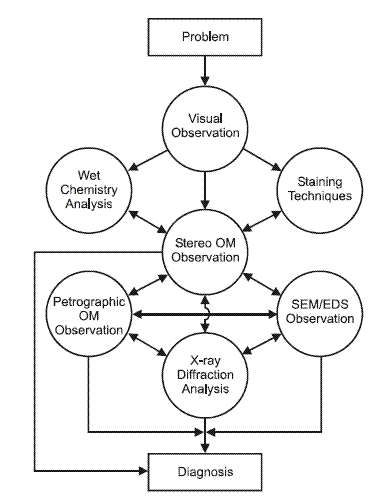
section 3.3 and form the basis for the preliminary examination plan covered in section 3.4. The various types of cracks, which may be observed at this stage, are discussed in chapter 4. Chapter 5 covers the preparation of various specimens for more detailed microscopic examinations. As illustrated in figure 23, stereomicroscopic examinations play a central role in most petrographic analyses. Procedures for the quantitative analyses of the air-void system and concrete constituents are given in chapters 6 and 7. General stereoscopic examinations and staining techniques are covered in chapter 8. The petrographic microscope and its use are discussed in chapters 12 and 13. The use of SEM and EDX are covered in chapter 14.
The different types of specimens that may be submitted are listed in table 5. For HCC, the word specimen is used and the word sample is usually avoided because the specimen is seldom a truly representative sample of the HCC placement. Clients may also submit a suite of related specimens. For the sake of brevity, the word specimen is used even when a suite of specimens is meant.
No matter what the reason or type of specimen, four general procedures are performed for each specimen received for petrographic examination:
|
Upon receipt of a specimen, six tasks are performed (as listed in table 6):
|
The documentation and oral exchanges between the petrographer and the client should make clear the proposed use of the data obtained by the petrographic examination. If the data obtained from the specimen will become part of a legal controversy, note this fact and consider it throughout the entire analysis. Particular shortcuts may be considered permissible for work done within one organization; however, data collected for presentation by an expert witness must be gathered in accordance with the exact procedures detailed by the test method employed. For example, ASTM C 457 states thatthree randomly selected test specimens are required to determine the compliance of the air-void structure with specification requirements.
Keep the original container (if any), the specimen, any documentation, letters of request,field notes, photographs, maps of the sampling plan, and other identifying papers together until all of these items have been entered into the logging system and the files of thepetrographic laboratory.
Mark and log the specimen: Mistakes are made in all laboratories; however, it is most important to avoid mistakes at the time the specimen is received. Many other errors can be corrected if one can be assured that the identifying marks on all of the individual fragments of the specimen and the original entries in the logbook and on the request documents are correct. Therefore, it is extremely important that this work be performed correctly and checked carefully. Do not do part of the job one day and leave the remainder to be done the next. The most important procedure is the marking so that the specimen will always be identifiable and never confused with any other specimen. Never assume that this or that specimen or this or that fact will be easy to remember. No petrographic procedure is more important than proper identification of the specimen.There can be no reason to postpone specimen identification until some other procedure is begun on the specimen.
Experimentation has shown that the most durable markings are those made with graphite (ordinary "lead" pencil, or carpenter’s pencil). Unfortunately, graphite markings are often difficult to find and distinguish on concrete surfaces. If a felt marker is used, the marks may have to be refreshed after the specimen is subjected to oil, acetone, or alcohol. Even India ink cannot always withstand the rigors of the solvents used in the petrographic laboratory. Great marking security can be achieved with the heavy use of graphite, with additional identification clearly marked with a felt marker.
The in-house specimen numbering system of the petrographic laboratory must be individual to the laboratory and nearly impossible to confuse with any other numbering system that may be associated with the specimen. For example, at VTRC, specimens fabricated in the concrete mixing laboratory have a numbering system called master numbers. The petrography laboratory receives specimens from the concrete laboratory with master numbers on them; however, it creates confusion if the petrography staff tries to use the master numbers as the sole means of identification. A petrography number is assigned to the specimen, and the master number is recorded in the logbook, as are all other identification marks that accompany the specimen.
Petrography specimen numbers are preceded by a "P" (e.g., P-1222). The appropriate petrography number (including the "P") is clearly marked on each specimen with a felt marker and graphite (see figure 24). Such numbers are called P-numbers. The use of P-numbers is the major method of tracking specimens and facilitating the location of datawhen questions concerning a specimen are received. The number is included on all correspondence in order that recipients of the correspondence may use the number for making inquiries concerning the specimen.
Figure 24. Core with P-number.
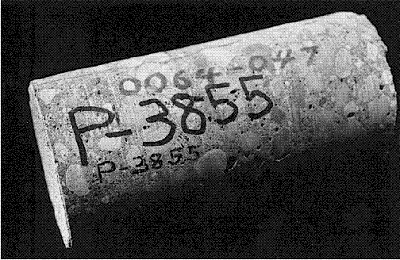
The original construction number is not obscured, and the P-number is marked with a felt marker and graphite.
CAUTION: Many ordinary inks begin to fade after they have been in contact with HCC paste for a few days. |
In the petrographic laboratories of VTRC, the most useful documentation of the receipt of a specimen was found to be a chronological log of all specimens entering the system (see figure 25). It is often used long after the original investigation has been concluded to discover when and how many specimens were submitted from a placement, what examinations were performed, where the specimens are currently, and how the data can be found. The logbook stays in one place and thus can be easily found. The log provides a guide to all the information available concerning a specimen from any source.
Entering the initial data must be easy and not very time-consuming. In its simplest form, the log might merely record the date; any specimen identification marking received on or with the specimen; the type of specimen received; the file number under which correspondence will be stored; and, most importantly, the petrography in-house specimen number. Indicate the general size of the specimen and whether the material: (1) was cored with a diamond-core drill from a hardened concrete placement; (2) was cast in a cylinder when the concrete was placed; (3) was produced in the laboratory or field as a cylinder, beam, or bar; (4) was found as a fragment; or (5) is a fragment that was sawed orhammered from a placement. Information that cannot be derived from the specimen should be available in the original documentation. In addition, the logbook can be used to record the progress of the investigation, tests performed, and disposal of the specimen or portions of the specimen.
Figure 25. Page from VTRC logbook.
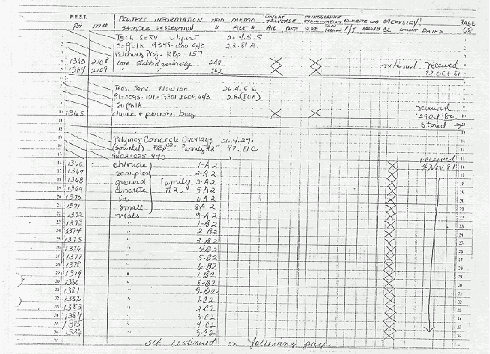
Figure 26. VTRC Request for Petrographic Services form.
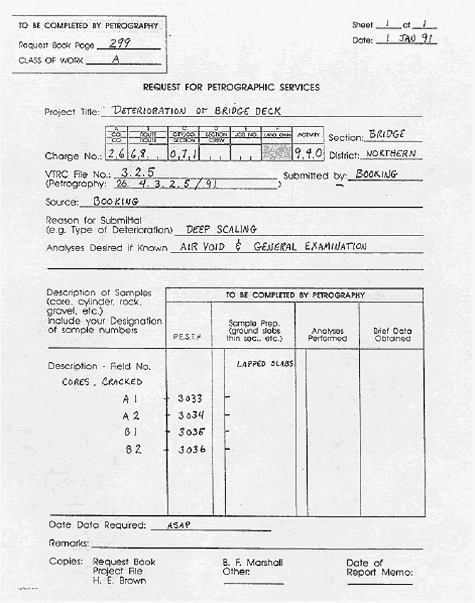
The first laboratory notes on the specimen are written during the initial examination. The specimen as received may be large; however, do not cut it to size until a complete plan of specimen examination has been drawn up. Use a hand lens or magnifying glass for examination until a reduction in size is a scheduled part of the plan. These preliminary notes and the client’s request provide the directions for the plan of petrographic analysis as discussed in section 3.4.
The initial examination is accomplished in six steps, as listed in table 7.
|
Become familiar with the material in chapters 4 and 10 so that you can recognize cracks and crack patterns symptomatic of particular phenomena such as plastic or drying shrinkage, AAR, and freezing and thawing damage. Take precautions to preserve evidence of these forms of deterioration.
Cracking that appears to be caused by plastic shrinkage (see chapter 4) is often cause for legal action and must be thoroughly investigated and photographed before any further procedures are performed on the specimen. Cracking that is caused by insufficient protection by an air-void system may be cause for litigation if it occurred soon after placement when the contractor could be held responsible.
Cracking resulting from AAR will usually not be a cause for legal action unless thematerials used were not those specified. It is probable that the client will want a complete description of the aggregates, the reaction, the reaction products, and how the reaction affects the concrete. Contact the client and inquire concerning the required breadth of thepetrographic investigation. The study of thin sections, photographs, and photomicrographs may be requested. The client will probably want sufficient information so that the reaction can be avoided in future concretes.
Cast cylinders submitted as specimens for determining the cause of low strength test results should be examined carefully for cracks, poor consolidation, or other signs of mishandling (improper storage or fabrication or both) that implicate flawed test specimens as the reason for low strengths. Contact the client and suggest compressive strength testing of specimens cored from the placement. If petrographic examination is required for other reasons, request replacement specimens (preferably cores). If replacement specimens are not available, try to avoid the flaws when planning the specimen preparation and make sure that the final report describes the condition of the cylinder and mentions the fact that the data obtained were not from the entire specimen.
In the case of a core or other specimen obtained from a hardened placement, try to judge which cracks are indigenous to the concrete in place and which cracks can be ignored because they were produced by the sampling procedures employed. Cracks produced by sampling procedures will usually appear fresh and will contain no reaction products;however, these criteria alone do not mean that sampling caused the cracks. If reaction products are present in the cracks or road dirt (dirt not caused by drilling the sample) is present in the vertical cracks, such features can be assumed to be indigenous.
A system of cracks parallel with the exposed surface (called scaling), especially if the cracks become more widely spaced with distance from the surface, is probably caused by cycles of freezing and thawing of saturated concrete either unprotected by a proper air-void system or containing unsound aggregates (see figure 27). The most important determination to be made on such concrete is an analysis of the air-void system.
Systems of vertical cracks visible on the surface and most closely spaced at joints and pavement edges are called D-cracking. In the Midwest, such cracks are usually caused by the deterioration of particular impure dolomitic aggregates under the conditions of cycles of freezing and thawing (Schwartz, 1987). In concretes containing sound (freeze-thaw durable) aggregates, such crack patterns may result from deterioration of the paste caused by the lack of an air-void system capable of providing protection from cycles of freezing and thawing (Andrews, 1953). When D-cracking is present, both the aggregate and theair-void parameters should be determined.
Figure 27. Scaling caused by cycles of freezing and thawing (occurred in concrete unprotected by a proper air-void system).
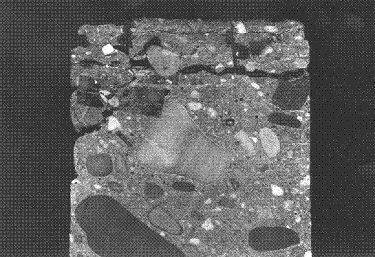
To photograph the cracking, the specimen was glued back together with a dark glue and then cut vertically across the layered cracking.
Figure 28. Cracking on surface and side of core with associated corrosion and expansion of the reinforcing bar.
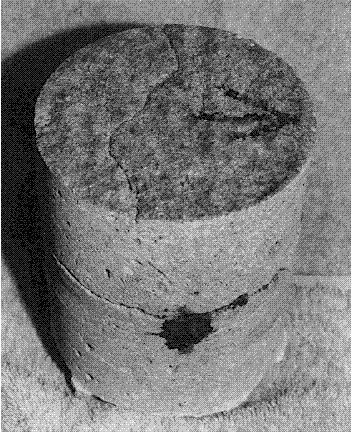
Figure 29. Delamination around reinforcing bars (there is no cracking on the surface).
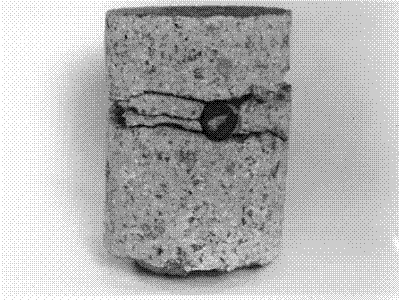
The thickness of the concrete over the reinforcement is an important aspect in reducing the tendency for settlement cracking (Dakhil, Cady, and Carrier, 1975; Price, 1982) and corrosion of reinforcement (Dakhil, et al., 1975; Cady, 1978; Perenchio, 1994).
Note any horizontal cracks on the specimens and record the depth of the occurrence of these cracks. Often these are indications of delamination at the level of the top steel.
Examine the bond between the paste and any other materials (such as reinforcement or anchoring pins) that are purposely present. Usually the bond should be tight and leave no space for the migration of fluids, wobble, or abrasive wear between the concrete and the other material (Lutz, 1994). Aluminum, zinc, glass, and many plastics may be used in HCC as connectors, electrical conduit, coatings on steel, and, recently, fiber reinforcement. These materials are subject to corrosion to varying degrees when enclosed in HCC in the presence of moisture, corrosive gases, or both. Some of these materials (e.g., aluminum) may prove quite deleterious (Erlin, 1994). Others, such as zinc, which has been used as galvanizing on steel reinforcement, usually only suffers superficial damage prior to the onset of active reinforcement corrosion. However, zinc will hydrolyze in highly alkaline plastic concrete with the evolution of hydrogen gas. Thisreaction is normally controlled with chromate treatments (Erli n, 1994). If not properly controlled, the reaction can result in a trail of voids to the surface. Note the condition of these materials and any associated cracks and reaction products.
If a finished roadway surface (wearing surface) is present on the specimen, note the texture of the surface: If the surface appears unusual or unable to provide skidresistance, consider the age, amount of traffic carried by the roadway, location of core with respect to wheelpaths, original specified texture, and weather during placement.Unless these data are already available, obtain information concerning these factors from the client. Consider preparing a thin section (see section 5.3.3).
Note general condition and unusual features insofar as is possible without the use of a microscope and with no preparation of the specimens: Wetting and partial-to-thorough drying of the specimen may reveal features such as fine cracking that are difficult to distinguish otherwise. If the client has submitted more than one specimen,be specific and note on which specimen the feature occurs. Observations should include,but not be limited to, the following:
Casts of ice crystals are evidence of early freezing. If the concrete is fragmented and casts of ice crystals are abundant on almost all of the fragments (as seen in figure 30), the concrete was forced apart by the expansion of the ice formed before the paste achieved final setting.
Ice crystal patterns, such as "jack frost" patterns, may be visible on the molded surface of cylinders. Take these patterns at face value. The cylinders were subjected to freezing temperatures; however, the patterns do not provide any evidence that the placed concrete was likewise frozen. Obtain a temperature history of the placed concrete and the cylinder concrete from the client before making any conclusions regarding these ice crystal molds. If the cylinders were treated as was the placed concrete, examine them for evidence of curing procedures and molds of ice crystals that may occur in freezing temperatures in fresh, improperly protected concrete (Rhodes, 1978).
A surface layer of concrete in which molds of ice crystals are prevalent (see figure 31) indicates that the immature concrete was subjected to extremely chilling conditions (cooled below freezing, often with a wind that removed the heat of hydration). The unhardened concrete can freeze to a depth of several inches and develop casts of the ice crystals, which become zones of weakness and channels for solutions.
Figure 30. Fragments of concrete destroyed by freezing before final setting.
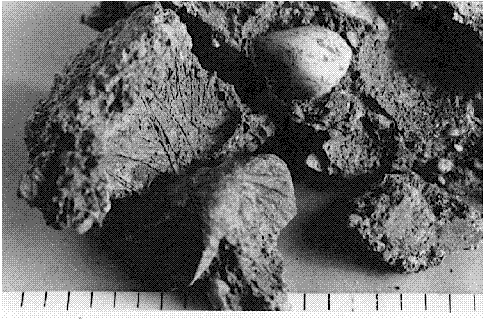
Figure 31. Surface sawed through concrete slab that froze before final setting.
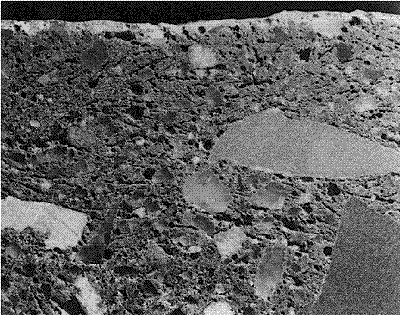
The blades of ice were, in general, parallel with the surface, and their orientation can be easily seen. The molds of the ice crystals are now empty and create zones of weakness throughout the concrete. Field width is 76 mm.
Photograph the specimen with a scale and identifying P-number labels: This step may be omitted if previous photographs of the specimen have recorded all visible features that caused concern to the client, the important features, and any differences among a suite of specimens submitted as one sample.
If the initial observations seem to answer the client’s questions completely, contact the client and ask if the investigation should proceed further. If the client is satisfied with the data already obtained, prepare all necessary written replies, permanent documentation, and the files as described in section 3.5.
Preparing a plan to analyze the specimen may be accomplished in four steps, as indicated in table 8. Van Dam, et al. (2002b) provide a series of flowcharts that can be used to help map out the examination plan.
|
With a felt marker, mark the first planes to be cut with the diamond-edged saw with full consideration of the need for a detailed examination of the various crack patterns (see chapter 4) and the likelihood of the need for an analysis of the air-void system: If the cutting plan is complex or if particular determinations must be made before the sawing is completed, it may not be possible to mark the cutting lines for all of the planes.
A slice approximately 15 mm in thickness is generally required for air-void determinations and general petrographic examinations. This thickness generally yields aslice that is strong enough to withstand normal laboratory wear and handling.If the HCC is badly deteriorated, has an extremely high air content, or is otherwise fragile, it may be necessary to use a somewhat thicker slice so that the integrity of the slice will be preserved during subsequent handling. In cases where one or two majorcracks exist in the specimen in the area to be sliced and the specimen has fallen apart or is about to fall apart, a strong epoxy may be used to keep the specimen together. Take care to prevent the epoxy from being squeezed or dripped into areas where it might obscure important features.
It is often necessary to reconstruct the specimen after cutting; therefore, place marks across all cutting planes (see figure 32). These marks are called match marks. Match marks should be unique to the cutting plane (one mark for the first plane, two marks for the second, etc.). Take care to avoid marking any surface that will be subjected to any form of analysis. Most inks (from pens and markers alike) can sink deeply into porous concrete and will probably not be completely removed by the lapping procedures. Ink marks can cause erroneous identification of aggregates and crack features and make the visualization of the paste features difficult.
Plan to cut across (at approximate right angles) any major cracks observed. Lapped surfaces produced on these cuts will enable better observation of the crack pattern.
The surface produced should allow the petrographer to see into cracks from the finely lapped surface.
Most commonly, surfaces are prepared by the technician cutting the material in a direction approximately perpendicular to a formed or finished surface of the HCC, and preferably across the layers in which the HCC was placed, thus producing a slice from the center of the material to be examined. This method is good when the size of the section produced does not exceed the capacity of the lapping equipment available or there are no obvious differences to be seen between the top and the bottom of the cores and the bottom portion can be ignored.
On occasion, it may be necessary to determine the differences between the individual air-void systems at various depths. When this is the case, the cutting plan will include taking horizontal slices at various depths and preparing each slice individually. Often,facing surfaces separated by only the thickness of the sawcut are considered as one specimen.
When the full depth of a core must be examined and the length of the core exceeds the size capacity of the lapping equipment, it may be necessary to saw the core horizontally into two or more pieces before preparing the slices to be surfaced.
|
Specimens: Three cores 100 mm in diameter and 125 mm in depth Preliminary examination: A visual estimate of the air-void content indicates that two of the three specimens have areas of abnormally high air-void content and there are patches of paste that are low in aggregate. Telephone report: The low strength is probably caused by a high void content. The patchy nature of the concrete may indicate retempering. Further client request: Conduct an analysis of the air-void parameters and complete a megascopic and stereomicroscopic petrographic examination. Plan of analysis:
|
|
Specimens: Two beams (75 by 100 by 400 mm) prepared for testing in accordance with ASTM C 666. They were subjected to identical treatment; however, an experimental chemical admixture was used in one beam. The concrete containing the admixture had a low dynamic modulus after the test. Preliminary examination: Conduct a cursory examination of the exterior of the beams. Plan of analysis:
|
|
Specimen: One core 100 mm in diameter, 75 mm in depth Preliminary examination of top and sides of core: Visual estimate of depth of damage. Telephone call by petrographer to client: How much pavement area looks just like the surface of the specimen sent to us? How many intermediate types of surface are there? If the area is extensive and the damage looks serious, send a sketch with the dimensions of the areas involved and a core specimen of each of the different portions of the placement affected by the rainstorm. Send pictures if possible. (Client sent three additional specimens of the surface and sketches.) Further client request: Detailed comments concerning damaged area and durability prognosis. Plan of analysis:
|
Figure 32. Core marked with identification, cutting planes, and match marks.
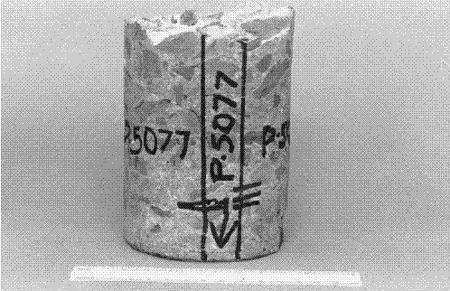
If specimens are photographed in the petrographic laboratory, keep the negatives and prints in the permanent file for the specimen. If the photography is performed by another division of the organization that maintains possession of all negatives, place a note to this effect in the file with the information needed to retrieve the negatives and prints.
Keep a permanent file in the petrography laboratory for each specimen that enters the system, even if the client’s questions have been answered. In the file, place copies of all the original documents, notes on any oral communications with the client, the updated request sheet, laboratory notes, printouts of the results of the tests, and copies of all correspondence. Correspondence will probably be filed by clerks or secretaries in a more formal filing system; however, that system may not have as much accessory data as does the file in the petrography laboratory. Keep a record of all testing procedures (such as air-void determinations). Such files are probably best organized by P-number and may be kept in the laboratory where the test was performed.
Keep a temporary file of request sheets of work in progress. As a job is completed, update a copy of the pertinent request form and move it to an archive file. This archive file will be useful when a question comes in concerning an old specimen and the date and P-number are unknown.